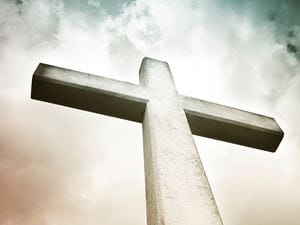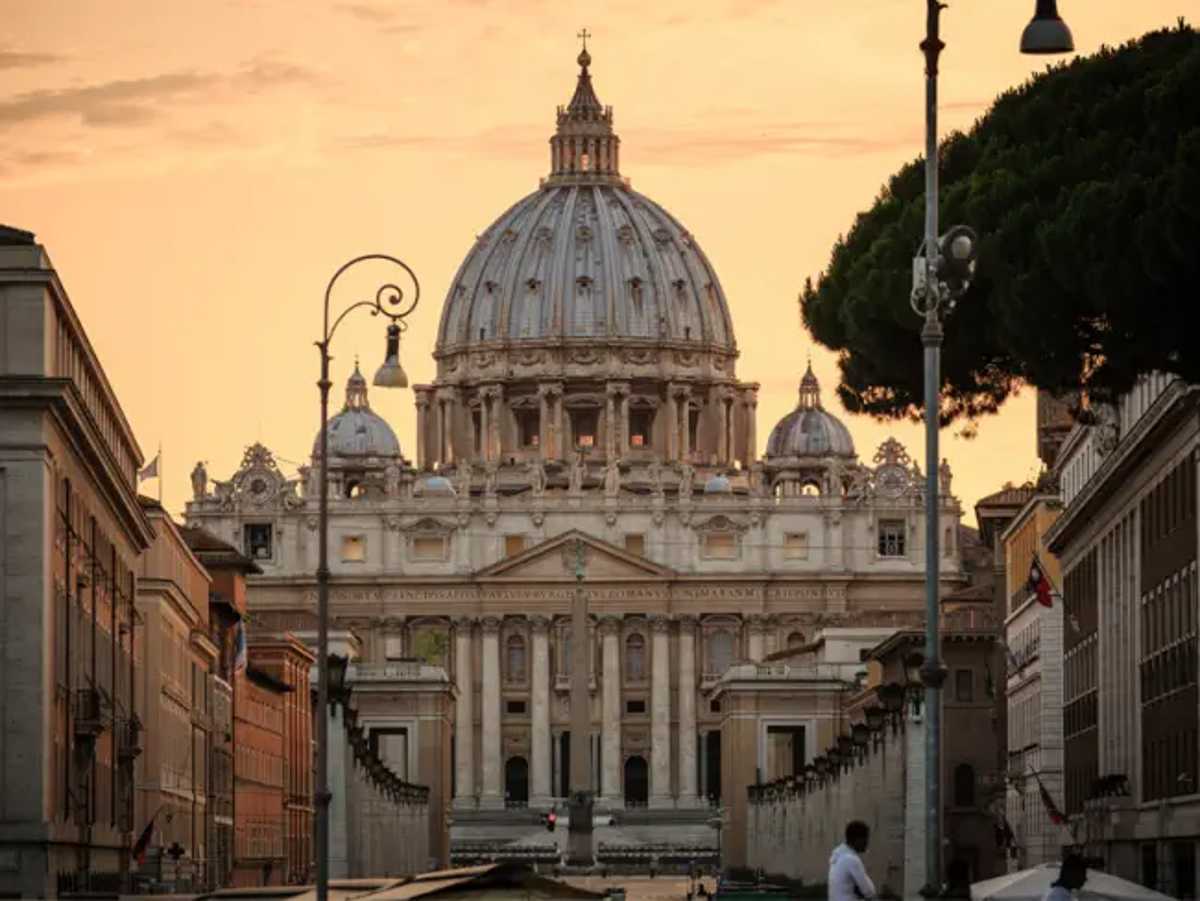
Making the sign of the cross seems like such a simple action. It takes less than a minute to complete. And, as Catholics, we do it so often that it’s all too easy to take it for granted and do it without giving it much thought.
But, in reality, it is the simple things that have the greatest impact on our lives. It’s also those simple things that can either empower us or weaken us as we deal with the more complex things in life. The former is true of the sign of the cross.
In September 1984, Saint John Paul II gave a homily to Canadian Catholics. To honor the solemn celebration for the Feast of the Triumph of the Cross of Christ, he spoke about what the cross means to all of us. “The Cross contains in itself the mystery of salvation, because, in the Cross, Love is lifted up,” the then holy pontiff said to the crowd. “This is the lifting up of Love to the supreme point in the history of the world: in the Cross Love is lifted up and the Cross is at the same time lifted up through Love. And from the height of the Cross, love comes down to us.”
Whenever we make the sign of the cross, we testify to the salvation found in that love. But there are many things that most of us don’t know about this sacramental. Here are just seven facets of the sign of the cross that you may not be aware of.
1. It has been important since the early church.
The sign of the cross has been made before and after praying and at the beginning and at the end of Mass since the early years of the Church. Not only that, but in the 4th Century, Saint Cyril of Jerusalem reiterated what the early Church fathers – including Terullian – had said about the importance of making the sign of the cross in all things, even in those parts of our daily lives that seem mundane.
In his Catechetical Lectures, the saint powerfully wrote about how vital it is to purposefully make the sign of the cross every day. He wrote “Let us then not be ashamed to confess the Crucified. Be the cross our seal, made with boldness by our fingers on our brow and in everything; over the bread we eat and the cups we drink, in our comings and in our goings out; before our sleep, when we lie down and when we awake; when we are traveling, and when we are at rest."
2. Originally the sign of the cross was made from right to left.
Around the 400s, a formal way of making the sign of the cross was instituted. But while it is still the way that Eastern Rites and Orthodox Catholics follow, it is different from the gesture that Catholics in the Western Church use to make the sign. Through around the 1100s, the sign was made with the thumb and fingers held together in a specific manner that symbolized two incredibly important aspects of our faith. It steadfastly affirmed our belief in the Holy Trinity, which also refuted heretics’ belief that Jesus wasn’t both God and man. And the positions of the thumb, forefinger and middle finger represented the Greek abbreviation IXC (Iesus Christus Soter, Jesus Christ Savior).
And it was made from the right shoulder to the left shoulder. Around the beginning of the 1200s, Pope Innocent III explained why. He said “This is how it is done: from above to below, and from the right to the left, because Christ descended from the heavens to the earth, and from the Jews (right) He passed to the Gentiles (left).”
3. It's now made from left to right.
From around the beginning of the 1200s onward, the formal way of making the sign of the cross changed for Catholics in the Western Church. Even though making the sign reminds us that Jesus is our Savior, we no longer hold our fingers and thumb in a specific way to form the Greek abbreviation IXC (Iesus Christus Soter, Jesus Christ Savior). Instead, we now use our open hands to make the sign, since we are blessing ourselves (mind, body and soul). And although our hands are open, we still affirm our belief in the Holy Trinity when we say “In the Name of the Father, and of the Son and of the Holy Spirit. Amen.”
The other distinctive difference for Catholics in the Western Church is that we now make the sign from left to right. Pope Innocent III also documented how this change occurred – due to priests beginning the tradition – and what it symbolizes. He wrote “Others, however, make the sign of the cross from the left to the right, because from misery (left) we must cross over to glory (right), just as Christ crossed over from death to life, and from Hades to Paradise. [Some priests] do it this way so that they and the people will be signing themselves in the same way. You can easily verify this — picture the priest facing the people for the blessing — when we make the sign of the cross over the people, it is from left to right...."
4. The sign of the cross is made with purpose.
Despite the fact that Western Church Catholics make the sign in a different way than the Catholics in the Eastern Rites and Orthodox Churches, we should be united in the sanctity of the action. We should allow the holy action to deepen our commitment to our faith. We should also offer our love and gratitude to the Holy Trinity when we make the sign of the cross.
In 2016, Reverend William Saunders wrote about the sign of the cross in the “Arlington Catholic Herald.” “No matter how one technically makes the sign of the cross, the gesture should be made consciously and devoutly,” Rev. Saunders wrote. “The individual must be mindful of the Holy Trinity, that central dogma that makes Christians Christians. Also, the individual must remember that the cross is the sign of our salvation: Jesus Christ, true God who became true man, offered the perfect sacrifice for our redemption from sin on the altar of the cross. This simple yet profound act makes each person mindful of the great love of God for us, a love that is stronger than death and promises everlasting life. The sign of the cross should be made with purpose and precision, not hastily or carelessly.”
5. It prepares us for the Mysteries of Faith.
In 2008, during the 150th anniversary of the apparitions of the Blessed Virgin Mary at Lourdes, Pope Benedict XVI addressed the many pilgrims who had travelled to the holy place where Blessed Mother had first appeared to Saint Bernadette. In his homily, he spoke of how the sign of the cross was an important part of the life-changing apparitions.
“This is the great mystery that Mary also entrusts to us this morning, inviting us to turn towards her Son,” Pope Benedict XVI said. “In fact, it is significant that, during the first apparition to Bernadette, Mary begins the encounter with the sign of the Cross. More than a simple sign, it is an initiation into the mysteries of the faith that Bernadette receives from Mary. The sign of the Cross is a kind of synthesis of our faith, for it tells how much God loves us; it tells us that there is a love in this world that is stronger than death, stronger than our weaknesses and sins. The power of love is stronger than the evil which threatens us. It is this mystery of the universality of God’s love for men that Mary came to reveal here, in Lourdes.”
6. The sign of the cross is connected to our baptism.
For those of us who were born and raised in the Catholic faith, one of the first times we encountered the sign of the cross was during one of the most important events in our lives. We experienced the blessing when we received the holy sacrament of Baptism.
At the beginning of the Baptism ceremony, the sign of the cross is made on our heads and close to our hearts. It signifies that we will belong to Christ. It also is a sign of the grace of redemption that Jesus gave us when He gave His life to redeem us.
Then, as children and adults, we are reminded of our Baptism through the sign. In most Catholic churches, Baptismal fonts filled with holy water are located near the church’s entrances. When we make the sign of the cross using the holy water, after entering the church, we once again make a commitment to Jesus in a special way. And we prepare ourselves to worship God. Later, when we make the sign of the cross before exiting the church, we prepare ourselves to take the Word of God and the Holy Eucharist that we received out into the world.
7. It prepares us for the Word of God.
While we make the sign of the cross at the beginning of the Mass and at the conclusion of the Mass, we also make it before and after we pray after receiving the Holy Eucharist. Additionally, we are asked to make the sign of the cross in a completely different way before the bishop, priest or deacon reads from the Gospel. At that part of the Mass, each person is expected to use his thumb and forefinger to form a little cross. Then, we must use those little crosses to trace tiny crosses on our foreheads, lips and hearts.
Making the sign of the cross in this way is actually an unspoken prayer. With it, we are asking God to permanently engrave the message of the Gospel on our minds, our lips and our hearts. It’s a beautiful way of asking God to enlighten and sanctify our thoughts, our words and our souls with the Word of God, so that we may live holy lives that are pleasing to God.
Although making the sign of the cross is a simple action, it is also a profound one that can empower us by strengthening our faith. It’s wonderful to reflect on several different aspects of this sacramental. But, above all, we honor the Holy Trinity and renew our commitment to our faith when we remember the infinite, miraculous sacrificial love present in the “Name of the Father, and of the Son and of the Holy Spirit” lifted up and pouring down from the Cross.

